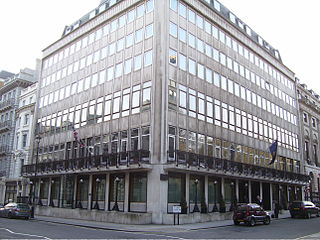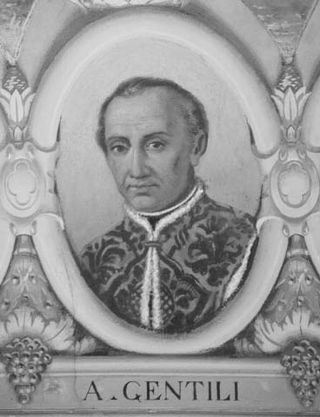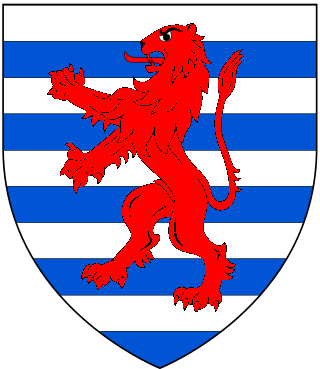The Treasurer of the Household is a member of the Royal Household of the Sovereign of the United Kingdom. The position is usually held by one of the government deputy Chief Whips in the House of Commons. The current holder of the office is Mark Tami MP.

The Carlton Club is a private members' club in the St James's area of London, England. It was the original home of the Conservative Party before the creation of Conservative Central Office. Membership of the club is by nomination and election only.

Sir Frederick Pollock, 3rd Baronet PC, FBA was an English jurist best known for his History of English Law before the Time of Edward I, written with F.W. Maitland, and his lifelong correspondence with US Supreme Court Justice Oliver Wendell Holmes. He was a member of the Cambridge Apostles.

Edward Cardwell, 1st Viscount Cardwell, was a prominent British politician in the Peelite and Liberal parties during the middle of the 19th century. He is best remembered for his tenure as Secretary of State for War between 1868 and 1874 and, with William Ewart Gladstone's support, the introduction of the Cardwell Reforms. The goal was to centralise the power of the War Office, abolish purchase of officers' commissions, and to create reserve forces stationed in Britain by establishing short terms of service for enlisted men.

William Baliol Brett, 1st Viscount Esher, PC, known as Sir William Brett between 1868 and 1883, was a British lawyer, judge, and Conservative politician. He was briefly Solicitor-General under Benjamin Disraeli and then served as a justice of the Court of Common Pleas between 1868 and 1876, as a Lord Justice of Appeal between 1876 and 1883 and as Master of the Rolls. He was raised to the peerage as Baron Esher in 1885 and further honoured when he was made Viscount Esher on his retirement in 1897.

Frederic Herbert Maugham, 1st Viscount Maugham, was a British barrister and judge who was Lord Chancellor from March 1938 until September 1939.

George Child Villiers, 5th Earl of Jersey, GCH, PC, previously George Villiers and styled Viscount Villiers until 1805, was a British courtier and Conservative politician from the Villiers family.

The Oxford and Cambridge Club is a traditional London club. Membership is largely restricted to those who are members of the universities of Oxford and Cambridge, including men and women who have a degree from or who are current students of either university.

Sir George Herbert Murray was a British civil servant.

The St James's Club was a London gentlemen's club which operated between 1857 and 1978. It was founded by two leading diplomats and its members continued to be largely diplomats and authors. It was first established in Bennet Street, and after a brief spell in Mayfair, moved to 106 Piccadilly by 1868. In the final quarter of the twentieth century many gentlemen’s clubs of London suffered from declining membership, and in 1978 the St James's Club merged with Brooks's Club and vacated its premises.

The Army and Navy Club in London is a private members' club founded in 1837 for British Army and Royal Navy Officers, it also known informally as The Rag. The Club offers Military membership to anyone who holds or has held a Commission in the British Armed Forces or in Commonwealth Forces, the club also now accepts applications for Non Military membership.

The Oriental Club in London is a private members' club that was established in 1824. Charles Graves described it in 1963 as fine in quality as White's but with the space of infinitely larger clubs. It is now located in Stratford Place, near Oxford Street and Bond Street. Based in an elegant building, the Oriental Club is one of the best members’ clubs for those in their 20s.

The Regius Chair of Civil Law, founded in the 1540s, is one of the oldest professorships at the University of Oxford.

Francis John Savile Foljambe was a British Liberal Member of Parliament.

Edward Augustus Stratford, 2nd Earl of Aldborough, of Belan house, styled The Honourable from 1763 to 1777 and Viscount Amiens in the latter year, was an Irish peer, Whig politician, and member of the Noble House of Stratford. He sat in the Irish House of Commons between 1759 and 1777 and in the British House of Commons from 1774 to 1775.

Brooks's is a gentlemen's club in St James's Street, London. It is one of the oldest and most exclusive gentlemen's clubs in the world.

The Eldon Law Scholarship is a scholarship awarded to students from the University of Oxford who wish to study for the English Bar. Applicants must either have obtained a first class honours degree in the Final Honours School, or obtained a distinction on the BCL or MJur. It is a two-year scholarship presently funded at £9,000 a year.
















